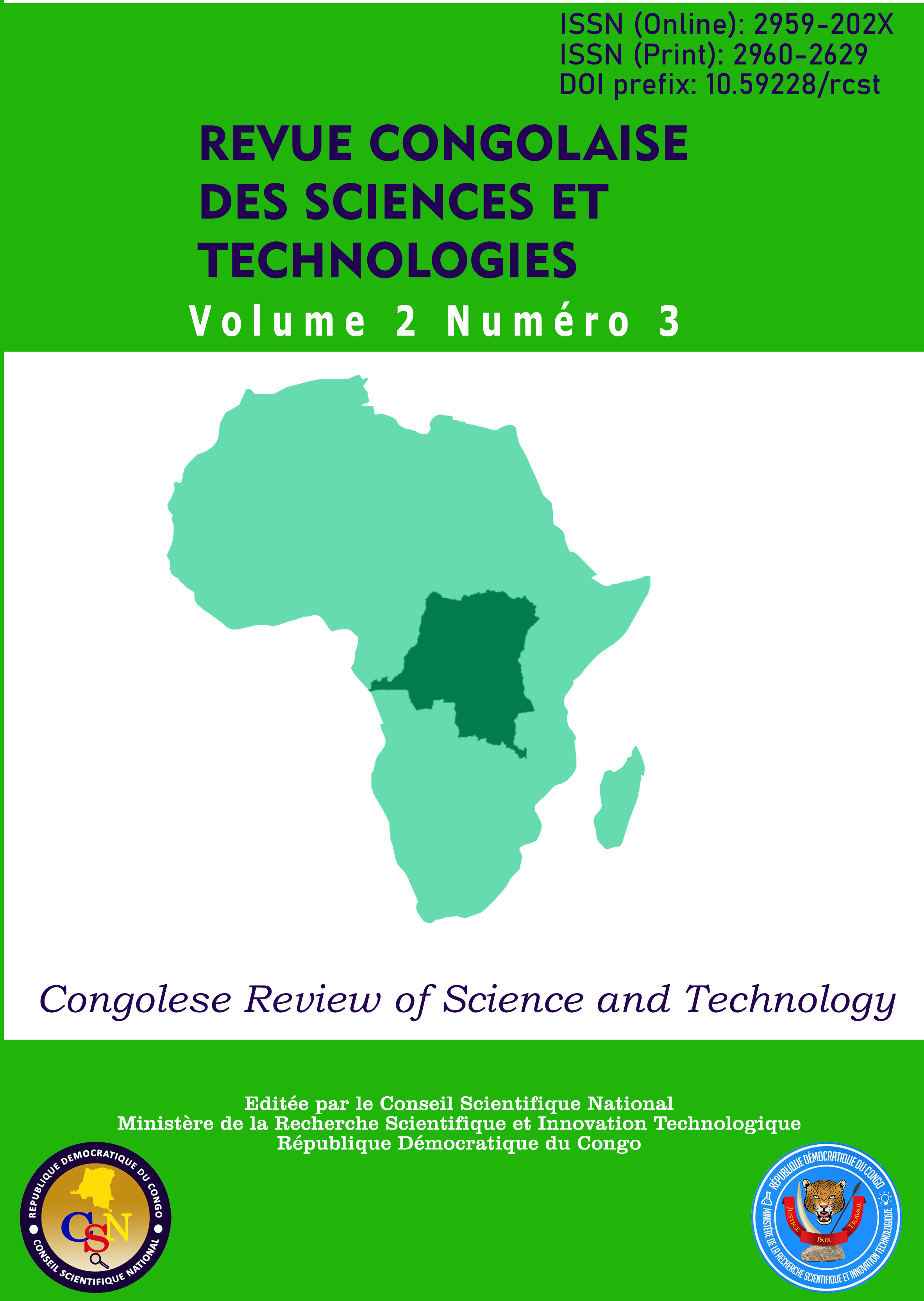In silico evaluation of the anti-sickling activity of some essential oil compounds of Lippia multiflora Moldenke (Verbenaceae)
Main Article Content
Abstract
In the context of sickle cell disease, a genetic disorder affecting red blood cells, the search for alternative treatments is crucial.
The aim of this study is to use computer simulations to predict the efficacy of certain Lippia multiflora compounds in
combating this hemoglobinopathy. The methodology used is based on molecular modeling and in silico simulation
techniques. Ten molecules of plant were selected and their three-dimensional structures were constructed. Molecular docking
simulations were then carried out to assess the binding affinity between these secondary metabolites and hemoglobin S. The
results reveal that four chemical compounds from Lippia multiflora (cycloeucalenol, luteolin, verbascoside and zitosterin)
show promising affinity with the target protein, suggesting the plant's anti-sickle cell potential. However, further experimental
studies are needed to validate these predictions (potential efficacy) in order to confirm the actual efficacy of this medicinal
plant. This in silico approach thus paves the way for faster, more cost-effective pre-selection of promising medicinal plants for
future development of treatments for sickle cell disease.
Article Details

This work is licensed under a Creative Commons Attribution-NonCommercial-ShareAlike 4.0 International License.
References
Agasa, B., Bosunga, K., Opara, A., Tshilumba, K.,
Dupont, E., Vertongen, F., Cotton, F., &
Gulbis, B. (2010). Prevalence of sickle cell
disease in a northeastern region of the
Democratic Republic of Congo : What impact
on transfusion policy? Transfusion medicine,
(1), 62‑65.
Kasai, E. T., Alworong’a Opara, J. P., Ntokamunda
Kadima, J., Kalenga, M., Batina Agasa, S.,
Marini Djang’eing ‘a, R., & Boemer, F.
(2022). Overview of current progress and
challenges in diagnosis, and management of
pediatric sickle cell disease in Democratic
Republic of the Congo. Hematology, 27(1),
‑140.
Masengo, C. A., Ngbolua K.N., Kwevi M.N.,
Kilembe T.J., Mihigo O.S., Kabena N.O.,
Tshilanda D.D., Tshibangu D.S.T., Ilumbe
B.G., Mpiana T.P. (2023). Quantitative
determination of Oxalic and Phytic acids of
Lippia multiflora Moldenke (Verbenaceae)
Leaves and in silico study of their interaction
with Haemoglobin S and 2, 3-DPG-Mutase.
Sumerianz Journal of Biotechnology 6(1), 1-
doi: doi.org/10.47752/sjb.61.1.10.
Masengo, C. A., Ngbolua, K. N., Omeonga, S. L.,
Nzuzi, N. P., Ilumbe, G. B., & Mpiana, P. T.
(2023). Étude phytochimique et évaluation de
l’activité anti-radicalaire, anti-inflammatoire,
anti-drépanocytaire et cytotoxique des feuilles
de Lippia multiflora Moldenke (Verbenaceae).
Revue Marocaine des Sciences Agronomiques
et Vétérinaires, 11(3), 303‑312.
Matondo, A., Dendera, W., Isamura, B. K., Ngbolua,
K.-N., Mambo, H. V., Muzomwe, M., &
Mudogo, V. (2022). In silico drug repurposing
of anticancer drug 5-FU and analogues against
SARS-CoV-2 main protease : Molecular
docking, molecular dynamics simulation,
pharmacokinetics and chemical reactivity
studies. Advances and Applications in
Bioinformatics and Chemistry, 59‑77.
Mpiana, P. T., Mudogo, V., Tshibangu, D. S. T.,
Kitwa, E. K., Kanangila, A. B., Lumbu, J. B.
S., Ngbolua, K. N., Atibu, E. K., & Kakule,
M. K. (2008). Antisickling activity of
anthocyanins from Bombax pentadrum, Ficus
capensis and Ziziphus mucronata :
Photodegradation effect. Journal of
Ethnopharmacology, 120(3), 413‑418.
Mpiana, P. T., Ngoy, E. M., Kilembe, J. T.,
Kabengele, C. N., Matondo, A., Inkoto, C. L.,
Lengbiye, E. M., Mwanangombo, D. T.,
Tshibangu, D. S. T., & Ngbolua, K. T. N.
(2021). Ocimum basilicum as a Potential AntiCOVID-19 Plant : Review on the Antiviral
Activity and Molecular Docking of Some of
Its Molecules with the SARS-CoV-2 Main
Protease (MPRO). Ocimum basilicum:
Taxonomy, Cultivation and Uses, 73‑111.
Mpiana, P. T., Tshibangu, D. S. T., Shetonde, O. M.,
& Ngbolua, K. N. (2007). In vitro
antidrepanocytary actvity (anti-sickle cell
anemia) of some congolese plants.
Phytomedicine, 14(2‑3), 192‑195.
Mulongo, E. K., Kilembe, J. T., Bongo, G. N.,
Dinangayi, D. T., Tshibangu, D. S. T., &
Mpiana, P. T. (2022). In silico screening of
natural compounds from Jatropha curcas
(Euphorbiaceae, Linn) and Jatropha
gossypifolia (Euphorbiaceae, Linn) against
SARS-CoV2, a COVID-19 main protease,
using molecular docking approach. IJFAC
(Indonesian Journal of Fundamental and
Applied Chemistry), 7(3), 148‑157.
Ngbolua, K. N., Kilembe, J. T., Matondo, A.,
Ashande, C. M., Mukiza, J., Nzanzu, C. M.,
Ruphin, F. P., Baholy, R., Mpiana, P. T., &
Mudogo, V. (2022). In silico studies on the
interaction of four cytotoxic compounds with
angiogenesis target protein HIF-1α and human
androgen receptor and their ADMET
properties. Bulletin of the National Research
Centre, 46(1), 1‑12.
Ngbolua, K.-N., Kilembe, J. T., Matondo, A.,
Masengo Ashande, C., Mukiza, J., Nzanzu, C.
M., Ruphin, F. P., Baholy, R., Mpiana, P. T.,
& Mudogo, V. (2021). Molecular Docking
Studies on the Interaction of Four Malagasy
Cytotoxic Compounds with Angiogenesis
Target Protein HIF-1α and Human Androgen
Receptor and Their ADMET properties.
Discovery Phytomedicine, 8(3).
Tshilanda, D. D., Onyamboko, D. N., Babady-Bila,
P., Ngbolua, K.-N., Tshibangu, D. S., dia Fita
Dibwe, E., & Mpiana, P. T. (2015). Antisickling activity of ursolic acid isolated from
the leaves of Ocimum gratissimum
L.(Lamiaceae). Natural products and
bioprospecting, 5, 215‑221.
Tshilolo, L., Aissi, L. M., Lukusa, D., Kinsiama, C.,
Wembonyama, S., Gulbis, B., & Vertongen,
F. (2009). Neonatal screening for sickle cell
anaemia in the Democratic Republic of the
Congo : Experience from a pioneer project on
204 newborns. Journal of clinical
pathology, 62(1), 35‑38.
Tunga, K. A., Kilembe, J. T., Matondo, A., Yussuf,
K. M., Nininahazwe, L., Nkatu, F. K.,
Tshingamb, M. N., Vangu, E. K., Kindala, J.
T., & Mihigo, S. O. (2020). Computational
analysis by molecular docking of thirty
alkaloid compounds from medicinal plants as
potent inhibitors of SARS-CoV-2 main
protease.. SDRP JACCMM. 2021. Vol.
(4):487-503. DOI:
25177/JCCMM.4.4.RA.10699.
Verber, D.F., Johnson, S.R., Cheng, H.Y., Smith,
B.R., Ward, K.W., Kopple, K.D. (2002).
Molecular properties that influence the oral
bioavailability of drug candidate. J Med Chem
:2615–2623. doi:

